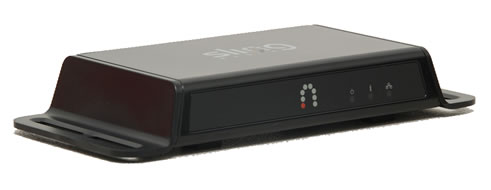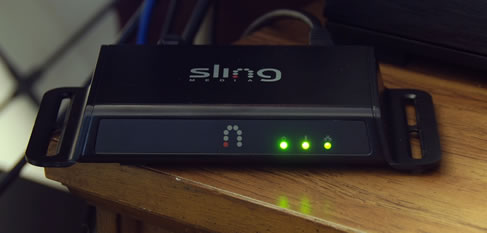Using the SlingLink Turbo 1-Port
Along with the Slingbox, we received the SlingLink Turbo 1-Port for evaluation. The SlingLink Turbo is an Ethernet bridge which allows a standard network signal to pass through power lines. If you don't have an Ethernet cable near your television where the Slingbox will be installed and don't want to fool with setting up a wireless bridge, you can use the SlingLink Turbo to deliver a network connection to a nearby electrical wall outlet.

Sling Media provided us with the 1-Port system, but you can also pick up a SlingLink Turbo with 4 ports. A multiple port system would allow you to connect other devices to your network, such as a PC or gaming console.

The complete package contains two SlinkLink Turbo units, quick start guide, two AC power cables, one Ethernet cable and four mounting screws.
The SlingLink Turbo units look like smaller versions of the Slingbox Pro-HD and share the same trapezoid shape. The front of each unit features the Sling Media logo in the center with three activity LED lights on the right: power, power line link and Ethernet activity.
Each side of the SlingLink has built-in brackets that allow you to mount each box to a wall or the back of your entertainment center using the included screws.

To set up the SlingLink system, take one of the units and connect it to your router using an Ethernet cable, then plug it to a nearby electrical power socket. The second SlingLink Turbo needs to be connected to your Slingbox via Ethernet and then to an electrical power socket.
Sling Media notes that you should plug the power connections directly into a wall socket and not use a power strip or surge protector, as these often have filters which will prevent the SlingLink from working properly. Initially I didn't like this idea, but according to the quick start guide, each SlingLink unit has its own power filter for protection against surges.
Once connected, everything should be good to go and you can use your Slingbox as you would with a normal network connection. Or at least, that is how it is supposed to work.
Upon initial testing with the SlingLink Turbo over my local network, signal strength was really low and the video lagged terribly. Even more strange was the fact that my touch lamp in the corner of my living room developed a life of its own and would cycle through its power phases (low, medium, high, off) at random.
After some online research, I learned that halogen lamps will interfere with the SlingLink Turbo and should be unplugged. Speeds increased after I unplugged the lamp, but this was a bit of a bummer as my living room is pretty dark with only one overhead light and my Batcave-style curtains covering the windows.



Having adjusted the encoding settings for maximum quality on the Slingbox Pro-HD earlier, I kept these settings when testing the SlingLink Turbo but there wasn't enough bandwidth available to keep pace. I was presented with a warning message alerting me that network conditions weren't good enough for my video settings and suggested I switch to SlingStream Optimization.
I took this suggestion and finally got a watchable video stream that unfortunately looked considerably worse than the direct Ethernet connection. Bit rates varied wildly in the 1500-3500 kbps range. This is a lot slower than the 8000 kbps I experienced over a direct Ethernet connection. Also, the buffer completely dropped off a few times and the video would freeze for a few seconds as it was buffering back up.
I live in an apartment complex so perhaps this had something to do with the relatively low speeds. I'm not an electrician but perhaps the signal was spreading to other apartments in the building and degrading between the two SlingLink Turbo adapters (they were about 15 feet away from each other on opposite walls).
Don't get me wrong, the video was totally watchable (aside from the occasional video buffer dump) and looked good, but if there's any way possible to run a physical Ethernet connection to your Slingbox, I would highly recommend doing so. It will save you some money and give you a much faster, no-nonsense connection.